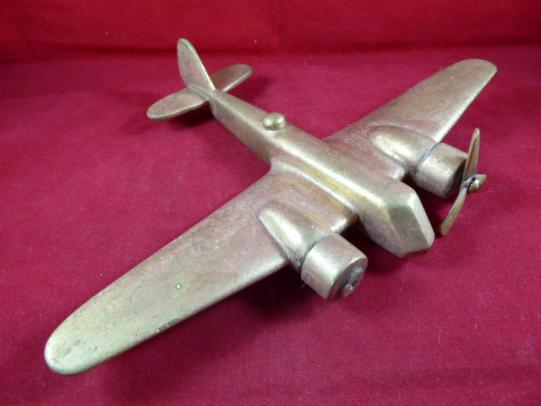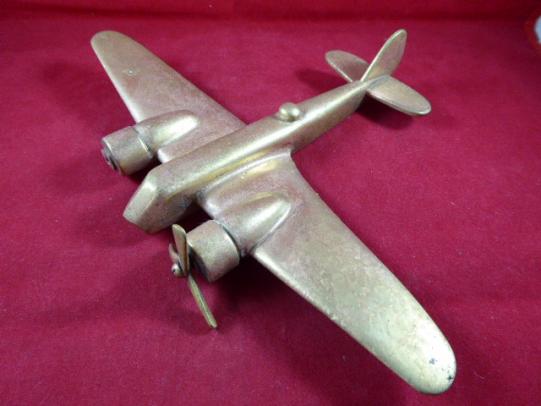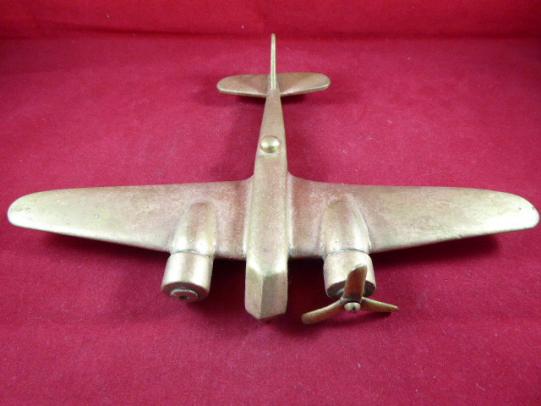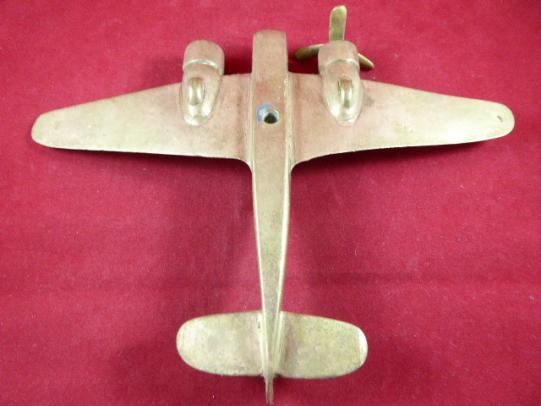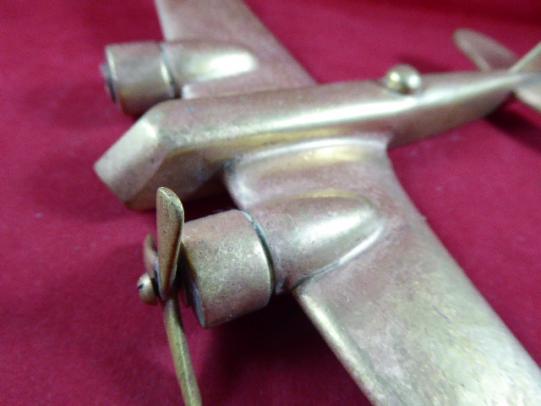WW2 Trench Art Solid Brass Model of an RAF Bristol Blenheim
Here on offer is an unusual example of a WW2 Trench Art solid brass model of a RAF Bristol Blenheim, twin engined light bomber.
The model is a one piece solid brass casting and does show as expected, some age oxidisation to the finish, but no cracks or repairs.
Originally it would have had two ‘three bladed’ propellers, but now one engine has its propeller, the other has been lost to time.
There is also a hole drilled in the bottom that allowed it to be fitted to a raised base or support.
Origins of the Bristol Blenheim Light Bomber / Heavy Fighter place it in the 1930s when Lord Rothermere, owner of the "Daily Mail" newspaper, set out a challenge to produce the fastest aircraft in Europe. From this came the Bristol "Type 142" with its sleek design holding much promise. It certainly went on to impress onlookers including Royal Air Force authorities who eventually considered it for military service (indeed it proved faster that some frontline fighters of the day). Specification B.28/35 was drawn up by the Air Ministry in 1935 to cover the conversion process of the fast plane to a three-seat, twin-engined light bomber / heavy fighter form. It was known to Bristol as the "Type 142M" and named Blenheim in RAF service. An initial order of 150 in 1935 followed and this was strengthened by a 1936 order for 434 more (as the Blenheim Mk.I).
Initial users were the airmen of Squadron No.114 during March of 1937 and a stock of hundreds were available when Britain went to war in September of 1939. However, of this total many were already stationed overseas in far-off places like the Middle East and Far East so they held little value in defending the home front and in attacking Axis positions across mainland Europe. The line was continually evolved throughout its early involvement in the war and this resulted in a few more specialized designs including a night fighters and several long-range performers.
Blenheims marked the first RAF violation of German airspace in the war when a flight crossed over into enemy territory on a reconnaissance mission near Wilhelmshaven (September 3rd, 1939). The next day, Blenheims attacked German naval positions at the Elbe Estuary but this force of ten was reduced to just five returning bombers and many of the dropped ordnance failed to detonate. The aircraft was continually pushed into action despite its shortcomings and spent time in the skies above Norway, France and the Low Countries. In these environments the aircraft proved its underperforming self and lacked suitable defensive capabilities - under-powered and under-gunned she was. This led to revisions of the armament suite, namely increasing the overall machine gun count carried. On March 11, 1940, a Blenheim claimed the RAF's first sinking of an enemy submarine (a German U-Boat).
The Blenheim equipped the first night fighter unit anywhere in the world when Squadron No.25 was given the type. During the "Battle of Britain" in the summer of 1940, a Blenheim night fighter claimed the first aerial kill while carrying radar when it downed a raiding German Dornier Do 17 Medium Bomber. The series played a crucial role in the night defence of Britain proper despite its inherent deficiencies in both performance and firepower.
The series soldiered on in anti-shipping sorties across the North Sea and in daring low-altitude runs against German infrastructure when possible. Overseas units were featured in the Middle East, Far East, North African and Mediterranean theaters (including time over Greece and Crete). Finland, becoming the first export customer of the Blenheim back in 1936 (both through direct order and local, licensed production), showcased the light bomber during its wars against the Soviet Union (the "Winter War" and the "Continuation War").
The line eventually served out its usefulness and was gradually replaced from 1942 onward by such designs as the American Douglas "Boston" and British de Havilland Mosquitoes and Bristol Beaufighters. The RAF gave up use of all Blenheims as soon as 1944.
Operators of the Blenheim (beyond the UK) included Australia, Canada, China, Croatia, Finland, France, Greece, India, New Zealand, Poland, Portugal, Romania, South Africa, Turkey and Yugoslavia.
In all, 4,422 Bristol Blenheims of all marks were produced including 44 from Yugoslav factories (by Ikarus) and 55 by Finland. Canadian factories (Bristol Fairchild) outputted 626 of the related "Bolingbroke" bombers from 1939 to 1943. The final frontline aircraft was not retired until 1956 by the Finns. The Bristol Beaufort (introduced in 1939) was an off-shoot of the Blenheim and 1,821 were produced in the UK and Australia.
The model has a 9” (22.8cm) wingspan and is 6” 15.3cm long.
It weighs a heavy 725g.
Please see my pictures for the details of the condition, which complement this description.
Please see my TERMS OF BUSINESS regarding Deliver Charges and Insurance regarding additional insurance cover, should you require it, BEFORE the item is dispatched.
The responsibility lies with the customer to check with your Customs restrictions that this item can be imported into your country.
Code: 50443
40.00 GBP

